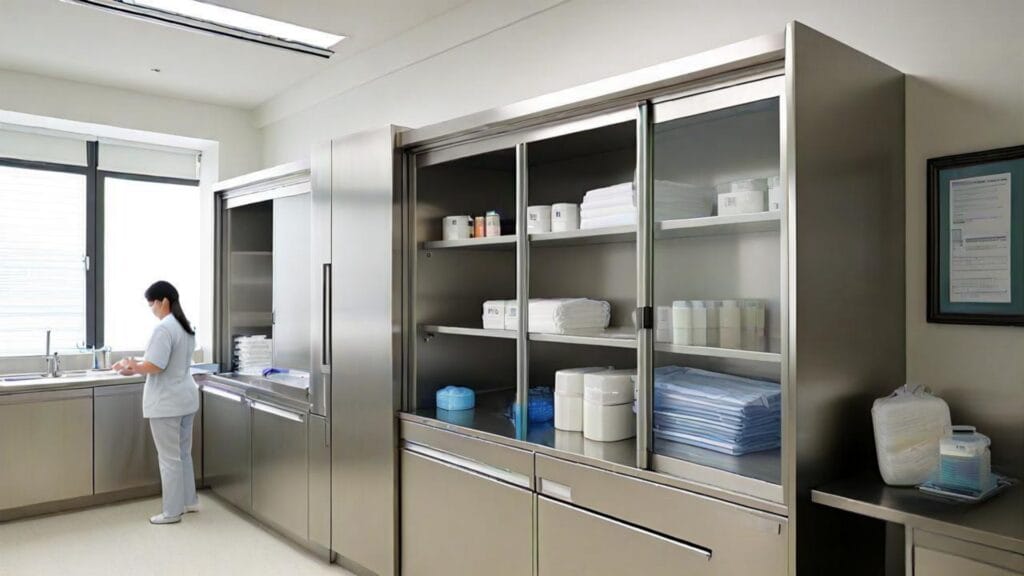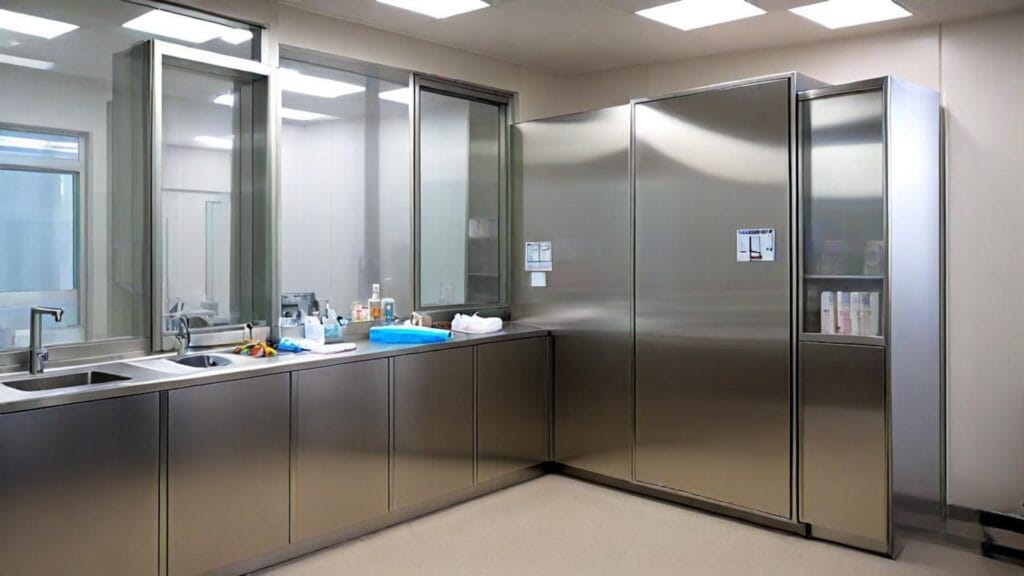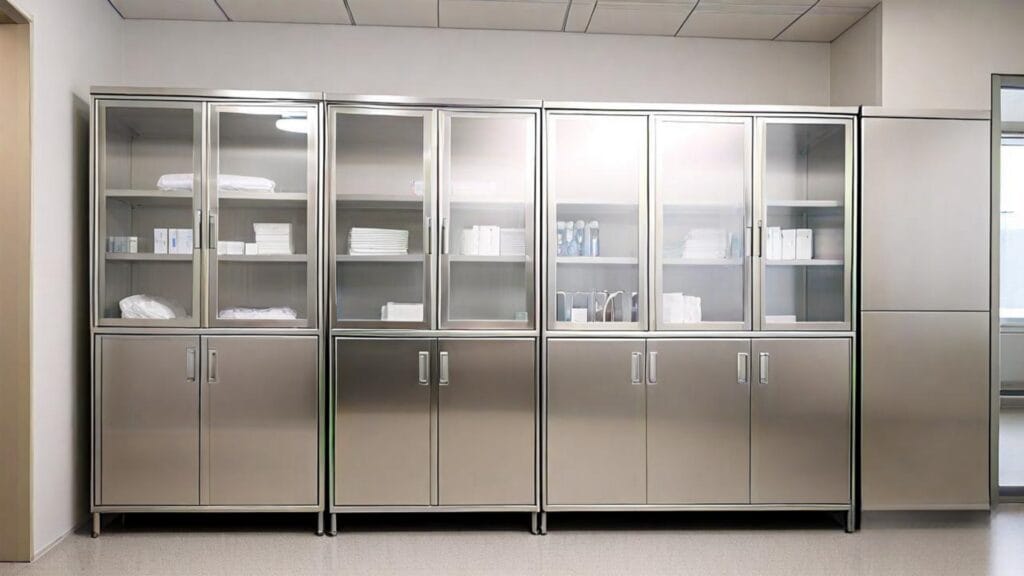Introduction to the Medical Furniture Industry

The medical furniture industry plays a pivotal role in enhancing the functionality and efficiency of healthcare settings. This segment of the healthcare sector encompasses a wide range of furniture designed specifically for clinical environments, including items such as examination tables, waiting room seating, treatment carts, and notably, stainless steel hospital cabinets. These products are essential for ensuring a hygienic and organized atmosphere, which is crucial for the delivery of high-quality patient care.
Stainless steel hospital cabinets are particularly significant within this industry. Their design and construction prioritize durability, easy maintenance, and resistance to corrosion – all vital attributes when it comes to healthcare furniture. Medical facilities require furniture solutions that can withstand the rigors of daily use while also meeting strict hygiene standards. This necessity for cleanliness and resilience is what sets medical furniture apart from general office furnishings.
The market for medical furniture has witnessed noteworthy advancements driven by technological innovations and the growing awareness of the importance of safety and efficiency in healthcare. Various manufacturers are now focusing on creating multi-functional and ergonomically designed products that cater to the evolving needs of hospitals and clinics. For instance, contemporary hospital cabinets are not only equipped for storage but are also designed to enhance workflow and optimize space utilization within treatment areas.
Moreover, as healthcare facilities continue to evolve, with an increasing emphasis on sustainability and eco-friendliness, the medical furniture industry is adapting accordingly. The integration of sustainable practices in manufacturing and the use of non-toxic materials are becoming more prevalent, appealing to a conscientious healthcare market. Thus, the evolving landscape of healthcare furniture, particularly the emergence of stainless steel hospital cabinets, reflects both a response to current challenges and a proactive approach to future demands in the medical field.
Current Market Landscape of Medical Furniture
The medical furniture industry has seen notable transformations due to various factors, most significantly the COVID-19 pandemic. This global health crisis has drastically altered consumer preferences and heightened the focus on hygiene, durability, and adaptability in healthcare settings. As a result, stainless steel hospital cabinets have emerged as a preferred choice among healthcare professionals due to their exceptional durability and ease of cleaning, which are crucial attributes in today’s heightened focus on infection control.
Key players in the market include established manufacturers and new entrants, each vying for a significant share of the healthcare furniture sector. Leading companies like Herman Miller, Steelcase, and Haldeman Homme have made substantial investments in research and development to innovate medical furniture solutions that not only meet industry standards but also incorporate modern design aesthetics. These manufacturers are increasingly integrating materials such as stainless steel into their product lines, thus catering to the rising demand for medical furniture solutions that ensure safety and efficiency in healthcare environments.
The competitive landscape is characterized by ongoing mergers and acquisitions, partnerships, and collaborations aimed at enhancing product offerings and expanding market reach. Major players are also focusing on developing strategic marketing initiatives to position their stainless steel hospital cabinets as essential components of a modern healthcare infrastructure. Additionally, the growing awareness of the importance of infection prevention has resulted in a shift towards furniture that minimizes microbial growth, thereby driving up the demand for stainless steel healthcare furniture that aligns with these hygienic requirements.
In conclusion, the current market landscape of medical furniture is defined by a growing preference for durable, hygienic products, such as stainless steel hospital cabinets. The confluence of consumer demand and the ongoing challenges posed by public health crises will continue to shape product development and market dynamics through 2025 and beyond.
Growth Trends in the Global Medical Furniture Market
The global medical furniture market has been experiencing significant growth, with projections indicating a compound annual growth rate (CAGR) of approximately 5% by 2025. This growth is largely driven by the increasing emphasis on improved healthcare standards and the rising demand for sophisticated healthcare furniture solutions. Notably, stainless steel hospital cabinets are gaining prominence due to their inherent hygienic properties and durability. With an escalating focus on infection prevention and control in healthcare settings, stainless steel offers a viable option for medical furniture solutions.
Recent trends indicate a shift towards sustainable and long-lasting materials in the production of medical furniture. Stainless steel stands out not only for its strength and durability but also for its ability to withstand rigorous cleaning protocols. This material’s resistance to corrosion and staining makes stainless steel hospital cabinets an ideal choice for hospitals and clinics striving to maintain sterile environments. The increasing awareness among healthcare providers regarding the importance of hygiene and safety has accelerated the demand for such medical furniture solutions.
Moreover, advancements in manufacturing processes and design technologies have led to the development of more stylish and ergonomic healthcare furniture. The integration of user-centric design principles in the production of medical cabinets ensures ease of use for healthcare professionals, thereby enhancing operational efficiency. As a result, the medical furniture market is witnessing a significant transformation driven by the demand for functional yet aesthetically pleasing designs.
Statistics show that the shift towards modular and customizable solutions is also on the rise, with healthcare providers seeking furniture that can be tailored to their specific needs. Consequently, metal furnishings, particularly stainless steel hospital cabinets, are being designed to accommodate various healthcare setups, reinforcing their role as a critical component in modern medical environments.

Rising Demand for Stainless Steel Hospital Cabinets
The demand for stainless steel hospital cabinets has witnessed a significant uptick in recent years, driven by several critical factors that underscore the importance of hygiene and durability in healthcare environments. One of the primary motivations behind this rising demand is the increasing awareness of infection control protocols. Healthcare facilities are now more focused than ever on implementing stringent measures to prevent healthcare-associated infections (HAIs), which has led to a heightened emphasis on selecting medical furniture solutions that contribute to a sterile environment.
Stainless steel hospital cabinets are recognized for their exceptional hygienic properties. Unlike wood or particleboard, stainless steel is non-porous, making it resistant to bacteria and viruses. The ease of cleaning these cabinets is another decisive factor in their growing popularity among healthcare professionals. Surfaces can be sanitized quickly and effectively, enabling medical personnel to maintain high standards of cleanliness while minimizing cross-contamination risks. As hospitals and clinics strive to adhere to enhanced infection control policies, the role of stainless steel hospital cabinets in supporting these practices cannot be overstated.
Additionally, the longevity and durability of stainless steel as a material further enhance its attractiveness as a preferred option in medical furniture solutions. These cabinets are designed to withstand rigorous daily use without succumbing to wear and tear, making them a cost-effective choice for healthcare institutions. The resilience of stainless steel against corrosion, stains, and impact ensures that these cabinets can endure the stresses of a demanding medical environment while maintaining their functionality and appearance over time. This blend of practicality and performance is pivotal in solidifying the stainless steel hospital cabinets’ position in the market, catering to the ever-evolving needs of the healthcare sector.
Health and Hygiene Needs Post-Pandemic
The COVID-19 pandemic has markedly transformed health and hygiene standards across various sectors, particularly in healthcare facilities. As hospitals adapted to combat the spread of the virus, the emphasis on sanitization and safety intensified, leading to a significant reevaluation of medical furniture solutions. Stainless steel hospital cabinets have gained prominence as they meet the new rigorous hygiene standards. This material is known for its non-porous surface, making it resistant to bacteria and easy to clean, which is a critical aspect in infection control within healthcare environments.
The increasing awareness regarding health risks has compelled healthcare providers to prioritize furniture that not only serves practical needs but also enhances overall safety protocols. The incorporation of stainless steel in essential medical furniture solutions is being viewed as an important investment. Unlike wood or laminate, stainless steel hospital cabinets do not harbor pathogens, thus providing a safer environment for both patients and staff. This shift has led to procurement strategies that focus on materials that promote cleanliness and long-term durability, important factors as operational costs are continually scrutinized in light of tight budgets.
Moreover, governmental and regulatory bodies have also implemented stricter guidelines, further necessitating the use of high-quality, hygienic materials in healthcare furniture. Facilities are now making purchasing decisions with a clear focus on sustaining a sanitary environment, thus elevating the demand for stainless steel hospital cabinets. The post-pandemic landscape presents a market ripe with opportunities for manufacturers and suppliers who can offer innovative medical furniture solutions that align with these heightened health expectations. As facilities continue to adapt to these new norms, the use of stainless steel for cabinets and other healthcare furniture components is expected to remain a critical element in the evolving landscape of medical environments.
Technological Innovations in Medical Furniture Manufacturing
The field of medical furniture manufacturing has experienced significant advancements owing to emerging technologies. Among these innovations, the production of stainless steel hospital cabinets stands out due to their durability, functionality, and design. These advancements not only enhance the quality of healthcare furniture but also address the increasing demands of the medical sector. One prominent technological innovation in this domain is the use of advanced materials and manufacturing techniques, which contribute to the development of robust medical furniture solutions that withstand the rigorous conditions of healthcare environments.
For instance, the implementation of computer-aided design (CAD) technology allows manufacturers to create highly customizable stainless steel hospital cabinets tailored to the specific needs of healthcare facilities. This personalization capability enables hospitals to optimize space utilization and enhance the overall aesthetics of their interior design. Furthermore, the incorporation of eco-friendly manufacturing processes is gaining traction, where sustainable materials and methods are utilized to minimize the environmental impact while maintaining the quality standards of medical furniture.
In addition to design improvements, the functionality of healthcare furniture has been significantly enhanced through the integration of smart technologies. Smart stainless steel cabinets equipped with IoT (Internet of Things) functionalities enable real-time monitoring of equipment and supplies, ensuring efficient inventory management. These features not only improve workflow efficiency but also contribute to patient safety and accessibility, making them an attractive choice for modern healthcare environments.
Overall, the continual evolution of medical furniture manufacturing driven by technological innovations presents substantial opportunities for manufacturers and healthcare providers alike. As these advancements unfold, the market for stainless steel hospital cabinets is likely to expand, paving the way for more sophisticated and versatile healthcare furniture solutions that cater to the evolving needs of the industry.

Market Opportunities for Stainless Steel Hospital Cabinets in 2025
The stainless steel hospital cabinets market is poised for significant expansion by 2025, driven by the increasing demand for hygienic and durable healthcare furniture solutions. As hospitals and healthcare facilities actively seek to improve infection control measures, the trend toward stainless steel solutions becomes more pronounced. Stainless steel is favored due to its non-porous surface, which inhibits the growth of bacteria and simplifies cleaning procedures, making it an ideal choice for medical environments.
Investment opportunities are expected to burgeon in emerging markets, particularly in regions with developing healthcare infrastructure. Countries in Southeast Asia, Africa, and Latin America are witnessing a surge in healthcare facility construction projects, presenting a prime opportunity for suppliers of stainless steel hospital cabinets. These markets require robust medical furniture solutions that satisfy international hygiene standards, and stainless steel cabinets are well-positioned to meet these needs.
Furthermore, the rising number of specialized healthcare facilities, including outpatient clinics and long-term care facilities, is generating additional demand for stainless steel hospital cabinets. These new establishments often prioritize hygiene and efficiency in their design and operational requirements. As such, they are likely to invest in high-quality medical furniture solutions that not only fulfill functional needs but also enhance the overall patient experience.
Lastly, technological advancements in manufacturing processes are expected to create new opportunities in the stainless steel cabinets market. Innovations in design and functionality, such as modular cabinets and integrated storage solutions, will cater to the unique needs of modern healthcare environments. Manufacturers that focus on research and development to adapt their products can capitalize on this evolving landscape, securing a competitive edge in the healthcare furniture sector.
Challenges Facing the Medical Furniture Industry
The medical furniture industry, specifically concerning stainless steel hospital cabinets, is encountering several substantial challenges that can hinder its growth and efficiency. One of the primary obstacles is the ongoing supply chain issues affecting the procurement of stainless steel. Fluctuations in raw material availability and drastic price changes can create significant hurdles for manufacturers in maintaining a consistent supply of healthcare furniture. These supply chain disruptions, often exacerbated by geopolitical tensions and global events, compel manufacturers to find alternative sourcing options, which may not always be feasible.
Furthermore, the medical furniture sector faces increasing competition from alternative materials such as plastic and polycarbonate. While these materials are often perceived as more cost-effective or lightweight, they may not offer the durability, reliability, and hygiene standards that stainless steel hospital cabinets provide. This competition can lead to pricing pressures, as customers may gravitate towards lower-priced options, affecting the market share of traditional stainless steel products. Manufacturers must thus navigate the challenge of convincing stakeholders of the long-term benefits of investing in stainless steel over potentially less expensive alternatives.
In addition to these obstacles, stringent regulatory requirements surrounding healthcare furniture add another layer of complexity. Compliance with safety, quality standards, and infection control measures demands significant investment and attention to detail from manufacturers. The need to frequently update designs and production processes to meet these evolving regulations can stretch resources and impact profitability. As such, it is critical for players within the medical furniture industry to remain adaptable and innovative in addressing these multifaceted challenges while pursuing opportunities for growth.
Conclusion and Future Outlook
The medical furniture industry is currently undergoing significant transformations, driven by advancements in technology, a heightened focus on hygiene, and evolving patient care needs. Stainless steel hospital cabinets have emerged as a pivotal component of this evolution, offering numerous advantages such as durability, ease of cleaning, and resistance to corrosion. As healthcare facilities prioritize safe and efficient environments, these cabinets are becoming integral to the overall design and functionality of modern healthcare furniture.
A noticeable trend is the increasing customization of medical furniture solutions to match specific operational requirements within various healthcare settings. This trend aligns with the growing demand for flexible and modular furniture that maximizes space without sacrificing quality or functionality. Stainless steel hospital cabinets can be tailored to include specialized storage options and configurations that cater to the diverse needs of medical professionals, enhancing workflow and patient care.
Looking forward, the market for stainless steel hospital cabinets is poised for growth, driven by several key factors, including the rising prevalence of chronic diseases, the expansion of healthcare facilities, and the increasing importance placed on infection control measures in medical environments. Businesses that specialize in healthcare furniture are expected to invest heavily in research and development to create innovative stainless steel designs that address both aesthetic and practical applications. Furthermore, environmentally sustainable practices may also shape the future of healthcare furniture, contributing to the creation of a more resilient and efficient medical framework.
In conclusion, as healthcare continues to evolve, the relevance of stainless steel hospital cabinets remains steadfast. These cabinets will play a crucial role in shaping the future of medical furniture by providing practical solutions that enhance the safety and efficacy of healthcare environments. The adaptability of stainless steel into various facets of healthcare design underlines its potential as a mainstay in the industry, clearly reflecting the opportunities that lie ahead for manufacturers and healthcare providers alike.


